Love the purple color? Then, planting some purple house plants to grow at home is a great choice!
But, what are the best purple house plants that you should grow at home? Some of the best purple house plants options you have are:
- Aglaonema—Also known as Chinese Everdeen, is a herbaceous perennial native to Northeastern Celebes and the Philippines.
- Job’s Beard—It is an attractive perennial plant native to the Carpathians and the Balkans in Europe.
These two are only the tip of an iceberg when it comes to the purple house plant choices. For the rest of the purple plant’s varieties, see them all below.
25 Best Purple House Plants to Grow at Home
1. Aglaonema
- Botanical name: Aglaonema commutatum
- Variety: Commutatum
- Origin: Northeastern Celebes, Philippines
- Family: Araceae
- Potential growth height: 10 inches to 3 feet tall
- Watering: Water the aglaonema plants when 50% of the soil is dry. Ideally, water it once every seven to ten days in summer and twice a week during winter.
- Best temperature: 70°F to 85°F
- Fertilizing: Once a month during the spring and summer months. Avoid fertilizing during winter months as plants aren’t actively growing in these times.
- Soil: Well-draining soil with sand or perlite (5.6 to 6.5 soil pH)
- Propagation: Division, stem cutting
Aglaonema, commonly known as Chinese everdeen, is an ornamental plant native to Asia. This plant was transported to the West in 1885.
When it comes to characteristics, the aglaonema plants have erect growing stems or creeping and decumbent. Their stems may root at the nodes when they grow from the grounds.
In addition, these plants possess spear-like leaves, reaching from 4 to 8 inches long with 2 to 3 inches in width. Furthermore, silver-gray spots appear on its upright stems, followed by red cluster berries after the blooms.
It’s best to know that this plant is poisonous due to its calcium oxalate content. This can cause concern for pet owners because when ingested, they can cause mucous membrane irritation.
In addition, their juice can produce severe rash and skin irritation. Some signs of aglaonema poisoning are:
- Swelling mouth (inclusive of lips, tongue, and esophagus)
- Foamy substance in the mouth
- Drooling
- Hard to swallow
2. Purple Heart
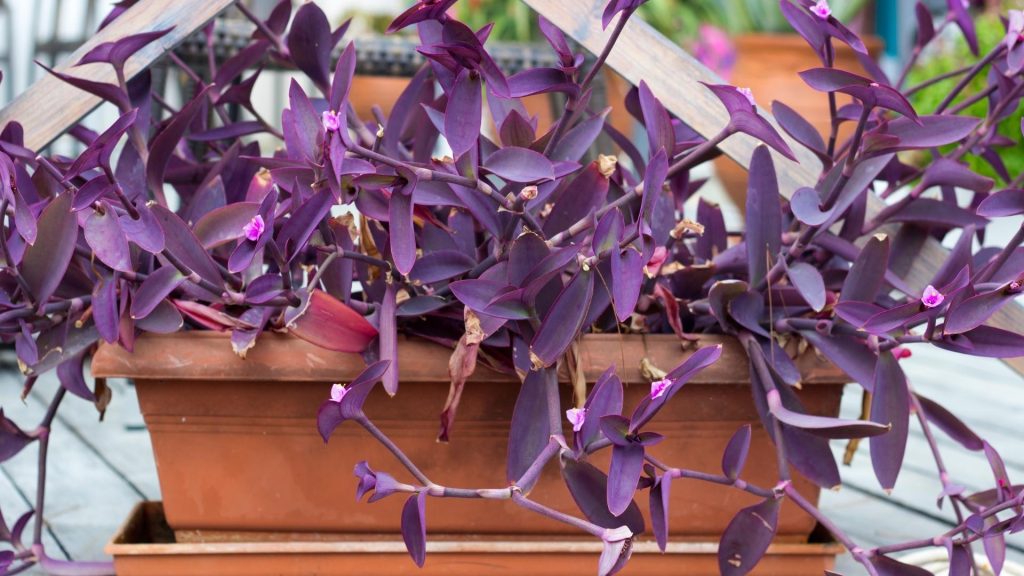
- Botanical name: Tradescantia pallida
- Variety: Pallida
- Origin: Northeast Mexico (Tamaulipas to Yucatan)
- Family: Commelinaceae
- Potential growth height: 14 inches tall (maturity)
- Watering: Once a week
- Best temperature: 65°F to 80°F
- Fertilizing: Once a month while the purple plants are actively growing.
- Soil: Moist, well-drained, lightweight (6 to 8 soil pH)
- Propagation: Leaf-cutting, root cutting, stem cutting
The purple heart plants are delicate everdeen perennials indigenous to Northeast Mexico, specifically from Tamaulipas to Yucatan. They have purple stems with violet leaves and pink flowers.
The flowers typically appear during summer. These plants look well on rock gardens, borders, or an edging plant.
To plant outdoors, make sure to choose a suitable location for this plant. Pick a spot with partial shade to full sun and organic soil that’s evenly moist.
3. Job’s Beard
- Botanical name: Sempervivum
- Origin: Africa and Eurasia
- Family: Crassulaceae
- Potential growth height: 3 to 6 inches tall
- Watering: Water it once or two times a week. Ideally, the job’s beard should be watered when the topsoil has dried up.
- Best temperature: 65ºF to 70ºF
- Fertilizing: Once a week with a diluted liquid solution (e.g., balanced 20-20-20 fertilizer)
- Soil: Clay, loam (Silt), high organic matter, sand (5.6 to 6 soil pH)
- Propagation: Division, seed
The job’s beard is a monocarpic succulent—which means flowering once. After it flowers once, the mother plant will perish, but the seed-filled fruit will carry on the production.
This purple house plant species best grows in well-drained compost with 50% gritty soil or sand. It is situated in full to partly sunny areas.
4. Tiger Stripes Kalanchoe
- Botanical name: Kalanchoe humilis
- Variety: Humilis
- Origin: Madagascar
- Family: Kalanchoe
- Potential growth height: 12 inches tall
- Watering: Water the plants when the two-inch deep of the topsoil is dry. This means you have to stick your finger to the soil every few days to check if the plant needs to be watered.
- Best temperature: 50°F to 70°F
- Fertilizing: Once a month during the summer and spring months.
- Soil: Loam, sand (5.8 to 6.3 soil pH)
- Propagation: Cuttings, seeds, leaves
The tiger stripes kalanchoe are large succulents with green leaves mottled with maroon and purple spots. They bear beautiful purple flowers during summer and show off their best color in full sun.
5. Cordyline ‘Tango’
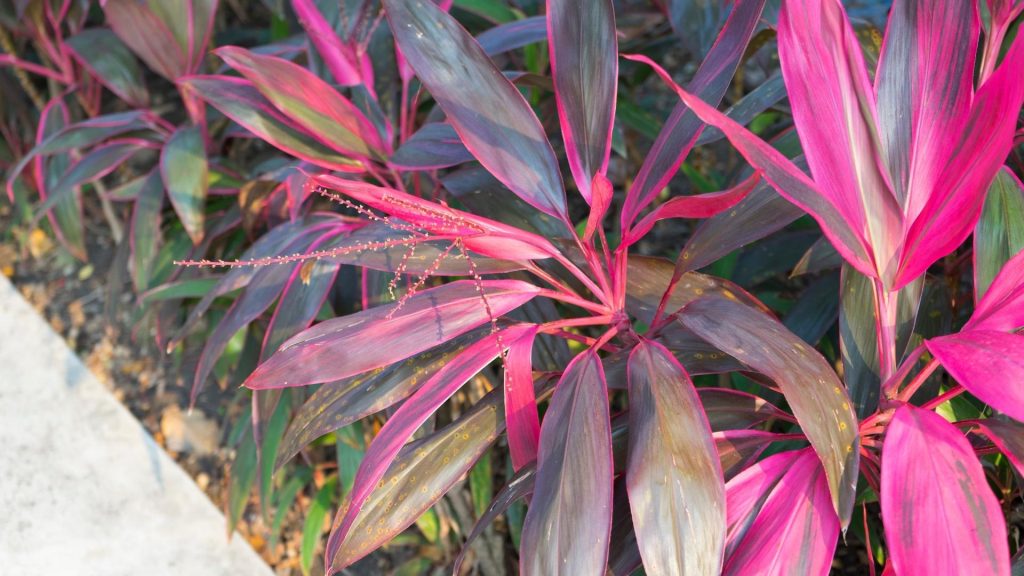
- Botanical name: Cordyline Fruticosa
- Variety: Fruticosa
- Origin: Southeast Asia, Pacific Islands, Eastern Australia
- Family: Asparagaceae
- Potential growth height: 10 feet tall
- Watering: Water the plant when the surface of the soil dries out.
- Best temperature: 65°F to 95°F
- Fertilizing: Once every other month
- Soil: Clay, chalk, sand, loam (6.0 to 6.5 soil pH)
- Propagation: Stem cuttings
Cordyline ‘Tango’ is a famous small tree or evergreen shrub with spear-shaped leaves. It has woody stems, slender strap-like leaves, and grey-green mottled foliage with broad bright pink edges.
This plant is easy to grow in organic, well-drained fertile soils and is low-maintenance. Moreover, this plant produces scented, tiny flowers every summer, accompanied by red berries.
6. Purple Sword
- Botanical name: Alocasia Lauterbachiana
- Variety: A. lauterbachiana
- Origin: Asia and Australia
- Family: Araceae
- Potential growth height: 1 to 3 feet
- Watering: Once a week with regular misting
- Best temperature: 65°F to 75°F
- Fertilizing: Once a month (summer and spring)
- Soil: Well-drained, loamy, or sandy soil mix (5.5 to 6.5 soil pH)
- Propagation: Divide (Split)
As the name suggests, the purple sword is spear-shaped, glossy with dark-green to purple leaves. It also possesses reddish undersides and scalloped edges.
Each leaf can grow as long as 2 feet, making it look like it’s one of a kind. The Alocasia or commonly known as the purple sword has been a great adornment plant to gardens and homes for ages.
Moreover, this plant is delicate yet can be put both indoors and outdoors. The alocasia or purple sword originated in Asia and Australia.
7. Ruby’s Necklace
- Botanical name: Othonna capensis
- Variety: Othonna capensis
- Origin: South Africa
- Family: Asteraceae
- Potential growth height: 4 feet tall
- Watering: Once a week or when the soil is fully dried out.
- Best temperature: 64°F to 70°F
- Fertilizing: Once a month (spring and summer)
- Soil: Well-drained soil mix (6.0 to 6.5 soil pH)
- Propagation: Clippings
The ruby’s necklace, or Othonna Capensis, is a rare plant that grows only in South Africa. This plant is a trailing succulent with bright purple to deep ruby red stems and dense green leaves, which blooms from late spring to early autumn.
On top of that, the flowers of this plant are bright yellow, contrary to its deep ruby-colored foliage.
8. Velvet Leaf Philodendron
- Botanical name: Philodendron gloriosum
- Variety: P. gloriosum
- Origin: Columbia
- Family: Araceae
- Potential growth height: 3 feet
- Watering: 1 to 2 times per week
- Best temperature: 65°F to 80°F
- Fertilizing: Once a month (spring to fall)
- Soil: Light, moist, well-drained, aerated potting mix (6.5 to 7.5 soil pH)
- Propagation: Stem cutting
Velvet leaf Philodendron is a beautiful Philodendron plant species with heart-shaped, velvety leaves. According to the International Union for Conservation of Nature (IUCN), its population trend has been decreasing in its natural habitat. It is listed as threatened species under IUCN’s international red list.
9. Persian Shield
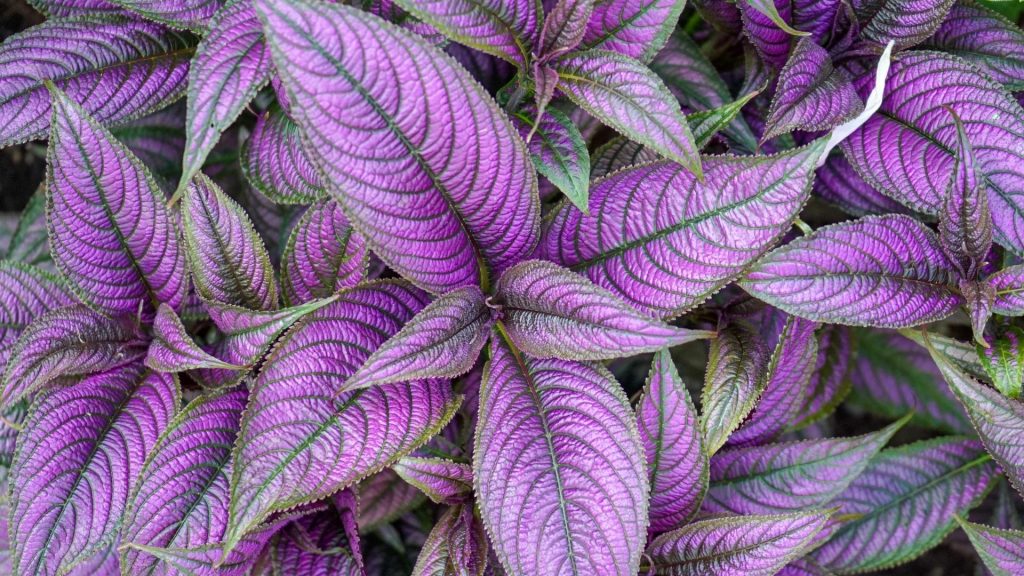
- Botanical name: Strobilanthes dyerianus
- Variety: S. dyeriana
- Origin: Burma (Myanmar)
- Family: Acanthaceae
- Potential growth height: 4 feet
- Watering: Twice a week
- Best temperature: 60°F
- Fertilizing: Every two weeks, ideally with half-diluted, low-NPK plant food
- Soil: Rich, well-drained soil (5.5 to 7.5 soil pH)
- Propagation: Seed, cutting
Persian Shield, scientifically known as Strobilanthes dyerianus, is a tropical, evergreen shrub native to Burma, Myanmar. It’s soft-stemmed and mainly grown for its charming, bright purple foliage.
It yields 4 to 7 inches long bent leaves with a point in its end. Moreover, it’s slightly jagged with dark green veins and a purple to the silver leaf surface.
10. Iron Cross Houseplant
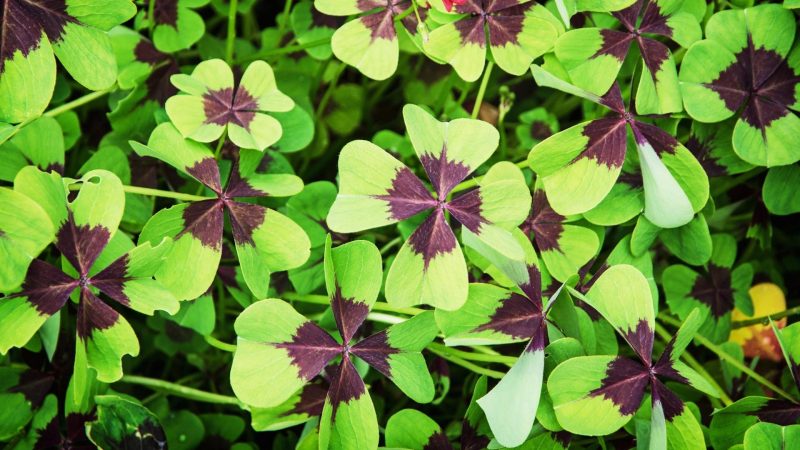
- Botanical name: Oxalis tetraphylla
- Variety: O. tetraphylla
- Origin: Mexico
- Family: Oxalis
- Potential growth height: 6 to 12 inches tall
- Watering: 2 to 3 times a month
- Best temperature: 60°F to 70°F
- Fertilizing: Every two to three weeks
- Soil: Humus-rich, fertile, well-drained soil (chalk, clay, loam, sand)
- Propagation: Cutting
Oxalis tetraphylla, commonly known as the iron cross houseplant, is a bulbous perennial plant. This species has deep green leaves, comprising four heart-shaped leaflets with a deep purplish spot on its base.
11. Silver Squill
- Botanical name: Ledebouria socialis
- Variety: Ledebouria
- Origin: Eastern Cape, South Africa
- Family: Asparagaceae
- Potential growth height: 6 to 10 inches tall
- Watering: Every nine days or when the top inch of the soil is dry.
- Best temperature: 60°F
- Fertilizing: Once a month
- Soil: Rich, well-drained (6 to 8 soil pH)
- Propagation: Division
Ledebouria socialis, commonly known as Silver Squill, is one of the most widely cultivated, teardrop-shaped bulbs with lance-shaped leaves. Its leaves are bright gray-purple with green spots and purple undersides.
Silver squill is typically cultivated as a houseplant and requires only minimal care. This plant only needs to be watered every nine days or when its topsoil is dry. In addition, it only requires fertilization once a month.
12. Rubber Plant
- Botanical name: Ficus elastica
- Variety: F. elastica
- Origin: Southeastern Asia
- Family: Moraceae
- Potential growth height: 6 to 10 ft. tall
- Watering: Once a week (spring and fall), every two weeks (winter)
- Best temperature: 50°F to 85°F
- Fertilizing: Every two weeks
- Soil: Fertile, well-drained soil (5.5 to 7.5 soil pH)
- Propagation: Cutting
Rubber plants or Ficus elastica are a species of flowering plants known for their leathery, glossy, broad leaves. They possess diverse colors like pink, cream, white, dark green, maroon, and blotched yellow.
These plants are native to Southeastern Asia and thrive well in bright light or low-light environments.
13. Iron-Cross Begonia
- Botanical name: Begonia masoniana
- Variety: B. masonia
- Origin: China and Vietnam
- Family: Begoniaceae
- Potential growth height: 1 ft. 6 inches
- Watering: Once to twice a week
- Best temperature: 60°F to 85°F
- Fertilizing: Once a month (year-round)
- Soil: Rich, fast-draining, humus-rich
- Propagation: Cuttings
Iron-Cross Begonia is a delicate perennial that’s cultivated as an ornamental houseplant. This plant is native to China and Vietnam and grows from a rhizome, noticed for its rare foliage.
Its leaves have a dark chocolate center marking, resembling the Iron Cross used during the Crusades.
14. Calathea
- Botanical name: Calathea insignis
- Variety: C. insignis
- Origin: Rio de Janeiro, Brazil
- Family: Marantaceae
- Potential growth height: 2 feet
- Watering: Twice a week
- Best temperature: 65°F to 80°F
- Fertilizing: Once a month
- Soil: High compost, low sand content (6.5 soil pH)
- Propagation: Division
Calathea, also commonly known as the Rattlesnake plant, is a herbaceous perennial evergreen. It possesses slender, erect foliage and wavy margins with purple undersides.
This plant is native to Rio de Janeiro, Brazil, and is known for its bright yellow flowers.
15. Waffle Plant
- Botanical name: Strobilanthes alternata
- Variety: S. alternata
- Origin: Jungles of Java, Indonesia
- Family: Acanthaceae
- Potential growth height: 6 to 8 inches tall
- Watering: Water whenever the soil feels barely damp.
- Best temperature: 55°F to 75°F
- Fertilizing: Once a month (summer and spring). No need to fertilize during fall and winter since plants naturally slow down their growth.
- Soil: Moist, well-drained soil ( 6.1 to 6.5 pH)
- Propagation: Stem cutting
The Waffle Plant has diverse nicknames, which include Red Flame Ivy and Metal Leaf plant. It got its name due to the ‘puckered’ look of its leaves.
It’s native to the jungles of Java, Indonesia, and can grow up to 8 inches tall. The waffle plant has leaf blades that are dark green in color on the upper face and light green to purple on the lower face. Moreover, the flowers of this plant are white with purple edges.
16. Caladium
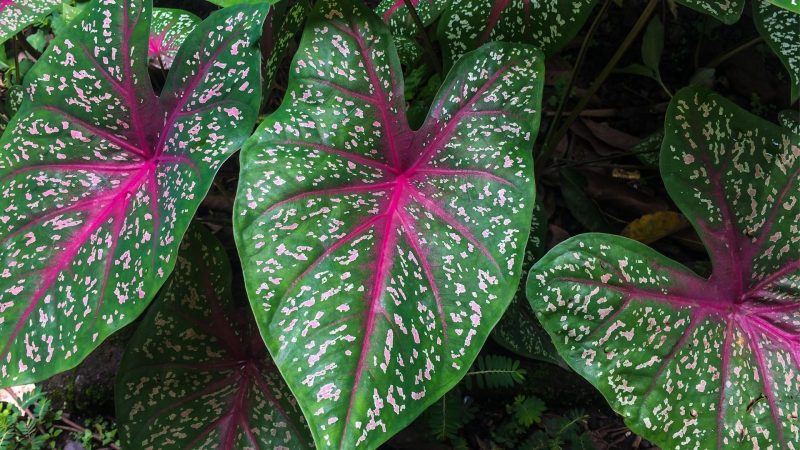
- Botanical name: Caladium bicolor
- Variety: C. bicolor
- Origin: South and Central America
- Family: Araceae
- Potential growth height: 1 ft. to 2 ft.
- Watering: Once a week
- Best temperature: 70°F
- Fertilizing: Every two weeks
- Soil: Humus-rich, well-drained (6.1 to 6.5 soil pH)
- Propagation: Dividing
The Caladiums are tropical plants with heart-shaped leaves. This plant is native to South and Central America from the Araceae family.
They can grow up to two feet and require to be watered once a week and thrive on organic and humus-rich soil.
17. Purple Passion
- Botanical name: Gynura aurantiaca
- Variety: G. aurantiaca
- Origin: Southeast Asia
- Family: Asteraceae
- Potential growth height: 3 feet tall
- Watering: Once every four to six days
- Best temperature: 60°F to 70°F
- Fertilizing: Every two weeks (spring through fall)
- Soil: Moist but not soggy, well-drained
- Propagation: Cutting
Purple passion houseplants are beautiful plants with velvety leaves and dense purple bristles on their green leaves. This plant has a cascading habit and grows best in moist soil with medium to bright light.
18. Rex Begonia

- Botanical name: Begonia rex-cultorum
- Variety: B. rex-cultorum
- Origin: Vietnam, Southern China, Northeastern India
- Family: Begoniaceae
- Potential growth height: 1 ft. to 1 ft 5 in.
- Watering: Once a week
- Best temperature: 65°F to 75°F
- Fertilizing: Once a week (spring through summer)
- Soil: Porous (5.7-6.2 soil pH)
- Propagation: Cutting
Rex begonias, also called painted leaf begonias, are typically grown for their remarkable foliage. Their leaves have diverse shades of silver, red, purple, and green with various textures and shapes.
For example, its leaves have a wide range of shapes—from hearts to ivy-like shapes to seashell twirls. Its color is often a mix of burgundy, green, and pink.
19. Ti Plant
- Botanical name: Cordyline minalis
- Variety: C. minalis
- Origin: Hawaii
- Family: Asparagaceae
- Potential growth height: 9.8 to 13.1 ft. tall
- Watering: Once a week or when the topsoil is dry.
- Best temperature: 50°F
- Fertilizing: Once a month (spring and autumn)
- Soil: Deep, moist but well-drained
- Propagation: Cutting
Ti plants are lovely plants native to Hawaii. They possess a variety of colors, including orange, red, pink, and chocolate, and don’t often produce flowers.
20. Wandering Jew
- Botanical name: Tradescantia zebrina
- Variety: T. zebrina
- Origin: Mexico and Guatemala
- Family: Commelinaceae
- Potential growth height: 6 ft. long
- Watering: Once a week
- Best temperature: 55°F to 80°F
- Fertilizing: Once a month (spring and summer)
- Soil: Well-drained yet slightly moist, peat moss based potting soil
- Propagation: Cutting
Wandering jew or Tradescantia zebrina are in-demand plants due to their beautiful bright colored leaves and vining habits. They’re best put in a hanging basket due to their cascading habit.
These plants are native to Mexico and Guatemala and thrive the best in a well-drained, peat moss-based potting soil.
21. Prayer Plant
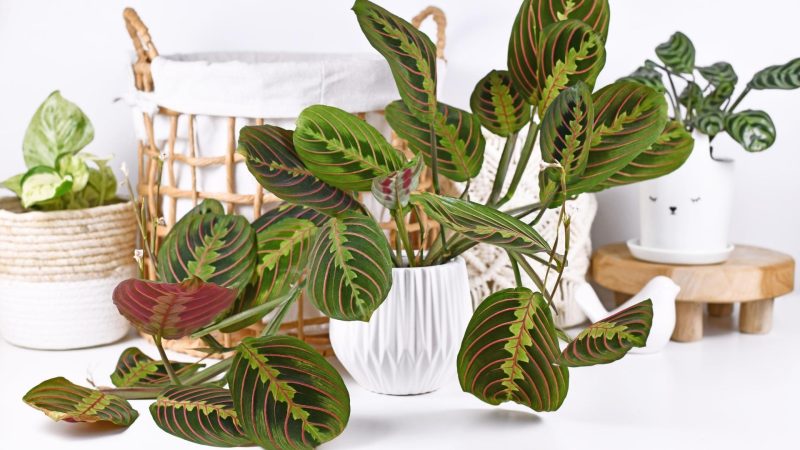
- Botanical name: Maranta leuconeura
- Variety: M. leuconeura
- Origin: Brazil
- Family: Marantaceae
- Potential growth height: 10 to 12 inches tall
- Watering: Every 3 to 5 days during summer
- Best temperature: 68°F to 85°F
- Fertilizing: Once every two weeks
- Soil: Well-drained soil, comprising peat moss, loam, and sand
- Propagation: Cutting
The prayer plant, also known as Maranta leuconeura, is a flowering plant species from the family Marantaceae. It’s native to Brazil and can grow up to 10 to 12 inches.
Furthermore, this evergreen tropical plant possesses spattered ovate leaves with gray-green to purple-green undersides. Its leaves fold at night, resembling praying hands, where it got its name.
22. Coleus
- Botanical name: Coleus scutellarioides
- Variety: C. scutellarioides
- Origin: Southeast Asia and Australia
- Family: Lamiaceae
- Potential growth height: 3 ft.
- Watering: Twice a day during summer
- Best temperature: 60°F to 75°F
- Fertilizing: Once a month
- Soil: Well-draining, fertile soil
- Propagation: Cutting
Coleus is an herbaceous perennial that comes from the Lamiaceae family. It’s native to Asia and Northern Australia and can grow up to 3 feet tall.
This plant thrives best in rich and moist loose soil in part shade. Placing it under the full sun can wilt it. On the other hand, putting it in the full shade can make its growth leggy—which means it’ll typically fall over.
23. Purple Oxalis
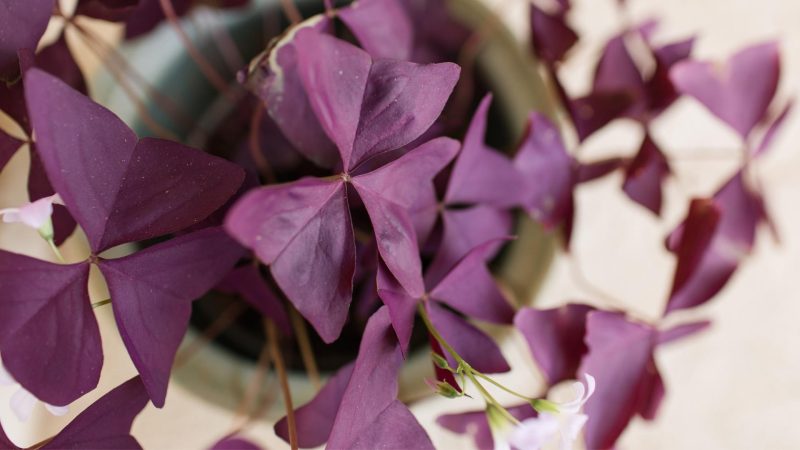
- Botanical name: Oxalis triangularis
- Variety: O. triangularis
- Origin: South America
- Family: Oxalidaceae
- Potential growth height: 1 ft.
- Watering: Once every two weeks
- Best temperature: 60°F to 75°F
- Fertilizing: Every two to three weeks
- Soil: Well-drained, sandy, loamy
- Propagation: Cutting
Purple oxalis, commonly known as the fake shamrock, is one of the rare plants with almost black leaves—which are deep purple. The leaves of this plant are triangular and come in a group of three.
During cloudy days or at night, they fold up similar to an umbrella and open up again when it’s morning. These plants bear tiny white or pink to lavender color and are best planted during spring.
24. Echeveria
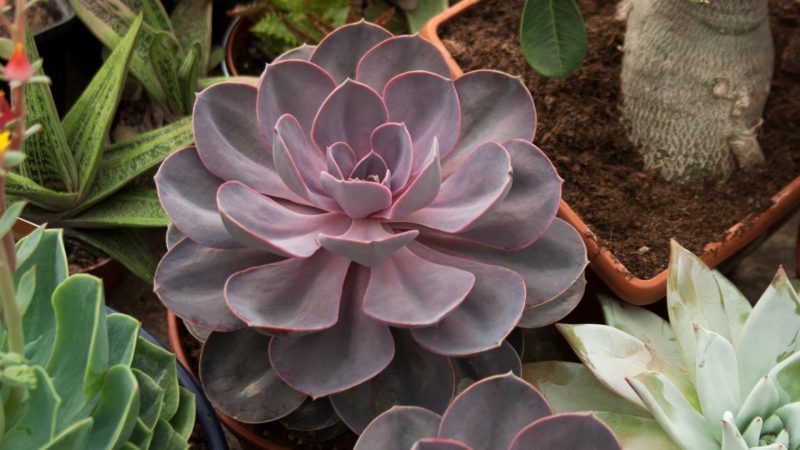
- Botanical name: Echeveria
- Variety: Echeveria
- Origin: Mexico and Central America
- Family: Crassulaceae
- Potential growth height: 12 inches tall
- Watering: Once a week
- Best temperature: 65°F to 70°F
- Fertilizing: Once a month
- Soil: Well-drained, sandy potting soil
- Propagation: Cutting
Echeveria is thick-leaved rosettes with waxy cuticles on their exterior. Usually, their leaves are colored and known to be slow-growing.
These plants are native to Mexico and Central America and naturally prefer desert-like conditions. However, they can also endure moisture periods as long as they’re completely dried out before any water application.
25. Greenovia
- Botanical Name: Aeonium dodrantale
- Variety: A. dodrantale
- Origin: Canary Island
- Family: Crassulaceae
- Potential growth height: 6 inches tall (maturity)
- Watering: Once to twice a week
- Best temperature: 65°F to 75°F
- Fertilizing: Once every two weeks
- Soil: Well-drained, sandy loam
- Propagation: Cutting
Greenovia is a rose-shaped succulent that comes from the Crassulaceae family. They’re rosettes of thickly packed leaves even when they grow. These plants are native to Canary Island and can grow up to 6 inches tall when they mature.
Summary
Purple house plants give off a royal vibe both indoor and outdoor due to their vibrant purple colors. Thus, they make an excellent addition to any plants you have at home.
So, if you’re currently looking for the best purple houseplant to grow at home, you may refer to the given list above.